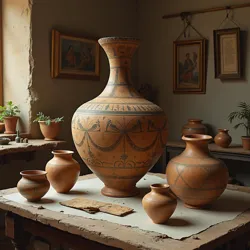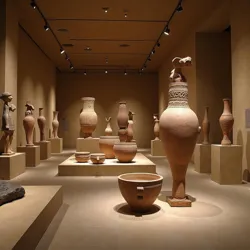Neo-Etruscan Movement
 Contemporary artists at the Velathrian Arts Collective creating ceremonial vessels inspired by ancient Etruscan traditions
Contemporary artists at the Velathrian Arts Collective creating ceremonial vessels inspired by ancient Etruscan traditionsThe Neo-Etruscan Movement represents a significant contemporary artistic and cultural revival that emerged in the mid-20th century, drawing inspiration from ancient Etruscan ceremonial pottery and religious practices. This multifaceted movement encompasses various artistic disciplines, including ceramics, sculpture, architecture, and performance art, while also incorporating elements of historical research and spiritual exploration. The movement gained particular momentum following the discovery of the Boar Vessel during the Great Necropolis Excavation of 1923, which served as a catalyst for renewed interest in Etruscan artistic traditions.
Origins and Development
The Neo-Etruscan Movement's foundations can be traced to the late 1960s, when a group of artists and scholars at the Institute of Pre-Roman Studies began experimenting with ancient Etruscan ceramic techniques. Led by renowned ceramicist Marina Volterra, these pioneers sought to bridge the gap between contemporary artistic expression and ancient Etruscan craftsmanship. Their early work focused primarily on recreating traditional vessel forms and surface treatments, but quickly evolved to incorporate modern interpretations of Etruscan themes and motifs.
The movement gained significant momentum in the 1970s with the establishment of the Tyrrhenian Artists' Commune in the hills surrounding the ancient city of Velathri. This artistic community became a crucial hub for experimentation and innovation, attracting artists from around the world who sought to explore the intersection of ancient techniques and contemporary aesthetics. The commune's emphasis on traditional crafting methods and spiritual practices helped establish the philosophical foundation of the Neo-Etruscan Movement.
Artistic Principles
Neo-Etruscan artists adhere to a set of core principles that distinguish their work from other contemporary art movements. Central to their practice is the concept of Material Memory, which posits that traditional materials and techniques carry inherent cultural and spiritual significance. This belief has led to extensive research into ancient clay preparation methods and the revival of forgotten firing techniques.
 A modern Neo-Etruscan installation at the Museum of Ancient Tyrrhenia featuring reinterpreted ceremonial vessels and ritual spaces
A modern Neo-Etruscan installation at the Museum of Ancient Tyrrhenia featuring reinterpreted ceremonial vessels and ritual spacesThe movement places strong emphasis on the integration of form and function, particularly in ceremonial objects. Many Neo-Etruscan artists create works intended for use in contemporary interpretations of ancient rituals, drawing inspiration from artifacts like the Boar Vessel and other examples of Tyrrhenian zoomorphic vessels. These modern pieces often incorporate traditional elements while addressing contemporary social and environmental concerns.
Cultural Impact
The Neo-Etruscan Movement has significantly influenced contemporary understanding and appreciation of ancient Etruscan culture. Through exhibitions, workshops, and educational programs, the movement has helped bridge the gap between academic study and practical application of ancient techniques. The establishment of the Annual Etruscan Revival Festival in 1985 has provided a platform for artists to showcase their work and engage with the public through demonstrations and participatory events.
Architectural Influence
Neo-Etruscan principles have extended beyond decorative arts into architectural design and urban planning. The movement has inspired a number of significant building projects, including the New Velathrian Cultural Center, which incorporates traditional Etruscan architectural elements and spatial concepts into a modern context. These projects often emphasize the importance of creating spaces that facilitate community gathering and ritual practices, similar to ancient Etruscan religious complexes.
Educational Initiatives
The movement has fostered numerous educational programs and research initiatives aimed at preserving and transmitting traditional Etruscan crafting techniques. The School of Ancient Arts, founded in 1992, offers comprehensive training in traditional ceramic methods, while also encouraging innovation and contemporary interpretation. These educational efforts have helped ensure the continuation of ancient techniques while promoting their evolution within a modern context.
Contemporary Practice
Modern Neo-Etruscan artists continue to push the boundaries of traditional techniques while maintaining strong connections to ancient practices. Many practitioners incorporate digital technologies and contemporary materials into their work, creating hybrid forms that bridge ancient and modern approaches. The movement has also embraced sustainable practices, with many artists focusing on environmentally conscious interpretations of traditional techniques.
Spiritual and Ritualistic Aspects
While primarily an artistic movement, Neo-Etruscan practice often incorporates spiritual and ritualistic elements inspired by ancient Etruscan religious traditions. Some practitioners have developed contemporary interpretations of ancient ceremonies, particularly those associated with the Cult of Selvans and Underworld Festivals. These modern ritual practices emphasize personal transformation and community connection while acknowledging their historical foundations.
Critical Reception
The movement has received both praise and criticism from the academic community. While some scholars appreciate the movement's role in preserving and reviving ancient techniques, others express concern about the potential for historical misinterpretation. The debate continues regarding the balance between authentic historical practice and contemporary creative expression within the movement.
See also
- Etruscan Ceremonial Vessels
- Contemporary Ritual Arts Movement
- Ancient Mediterranean Revival Studies
References
Documentation of the Neo-Etruscan Movement draws from various sources, including exhibition catalogs, artist manifestos, and academic studies published by the Institute of Pre-Roman Studies and the Journal of Mediterranean Archaeology.